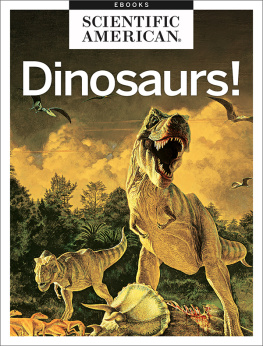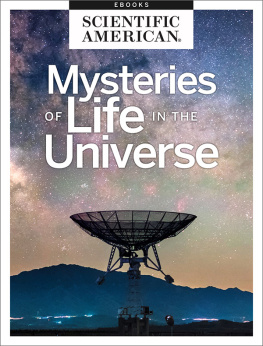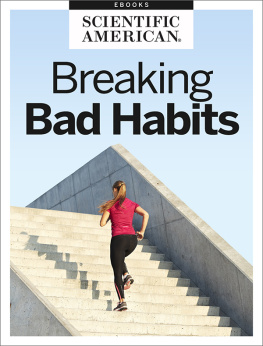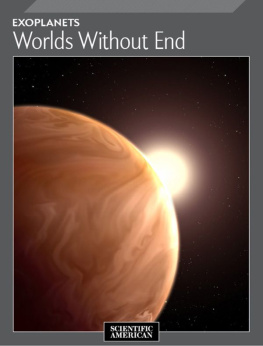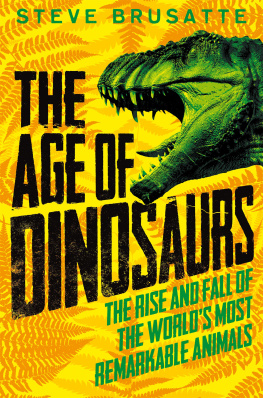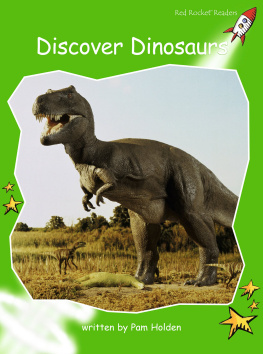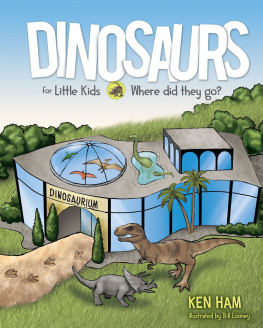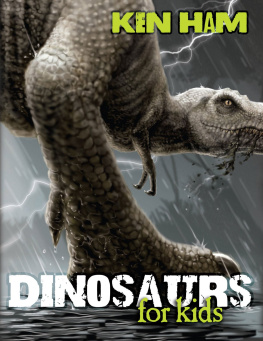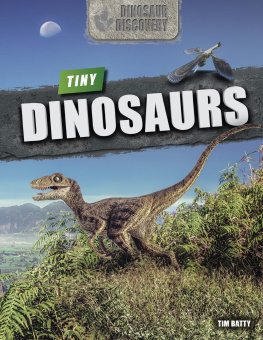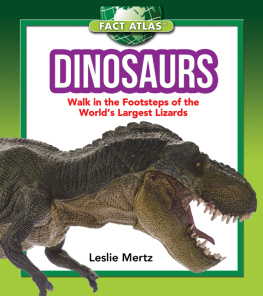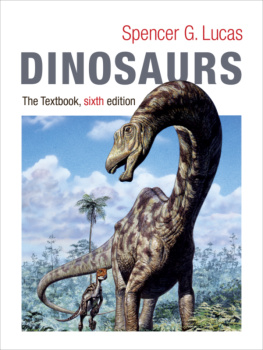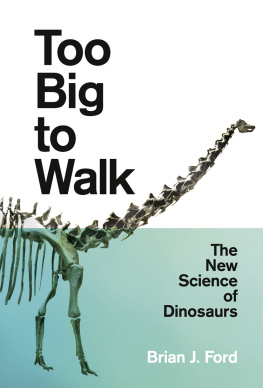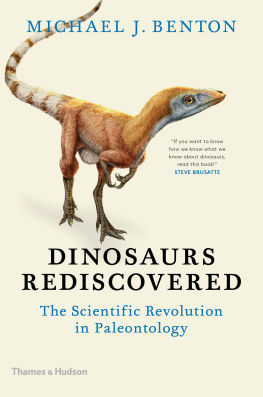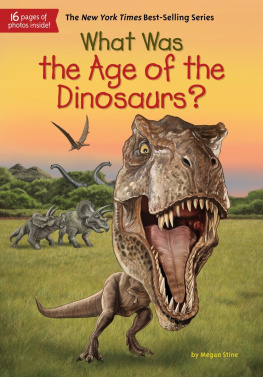Dinosaurs!
From the Editors of Scientific American
Cover Image: Kazuhiko Sano
Letters to the Editor
Scientific American
One New York Plaza
Suite 4500
New York, NY 10004-1562
or editors@sciam.com
Copyright 2017 Scientific American, a division of Nature America, Inc.
Scientific American is a registered trademark of Nature America, Inc.
All rights reserved.
Published by Scientific American
www.scientificamerican.com
ISBN: 978-1-4668-5894-7
Scientific American and Scientific American MIND are trademarks of Scientific American, Inc.,
used with permission.


DINOSAURS!
From the Editors of Scientific American
Table of Contents
Introduction
by Dawn Stover
Section 1
1.1
by John R. Horner, Kevin Padian and Armand de Ricqls
1.2
by Kristina A. Curry Rogers and Michael D. DEmic
Section 2
2.1
by Scott D. Sampson
2.2
by John J. Flynn and Andr R. Wyss
2.3
Gregory M. Erickson
Section 3
3.1
by Patricia Vickers-Rich and Thomas Hewitt Rich
3.2
by Anthony R. Fiorillo
3.3
by Raymond R. Rogers and David W. Krause
Section 4
4.1
by Gareth Dyke
4.2
by Richard O. Prum and Alan H. Brush
4.3
by Gareth Dyke
Section 5
5.1
by Paul C. Sereno
5.2
by Mary H. Schweitzer
5.3
by Mary H. Schweitzer
The Monsters We Adore
[Editor's Note: this eBook was originally published as a special edition of Scientific American.]
Terrible lizards. thats what the word dinosaurs means. yet dinosaurs are not true lizards, and they are not necessarily terrible either. What they are is endlessly fascinatingand still able to surprise us.
Paleontologists have overturned one misconception after another: As it turnsout, dinosaurs were not necessarily sluggish and cold-blooded. Many dinosaurshad feathered skins long before the origin of birds. And not all dinosaurs were enormous:some were less than a foot long. Others, of course, grew to be more than 100 feet long, andgrowth lines in dinosaur bones are providing clues about how quickly these animals reachedfull size, as John R. Horner, Kevin Padian and Armand de Ricqls explain in How DinosaursGrew So Large and So Small. Even in the American West, where manyof the earliest discoveries were made, there have been surprises. We now know, for example,that distinct communities of ancient behemoths once shared a relatively small landmass;Scott D. Sampson writes about their lives in Dinosaurs of the Lost Continent.
We still have much to learn about dinosaurs: the details of how they looked and sounded,exactly what they ate, and what kind of interactions they had with one another and with otherspecies. For example, although recent research has revealed that Tyrannosaurus rex couldbite down with tremendous force and then rake its teeth deeply through flesh and bone, paleontologistsstill are not sure whether T. rex was primarily a predator or a scavenger, as GregoryM. Erickson points out in Breathing Life into T. rex.
Calling someone a dinosaur is supposed to be an insult, but its a misguided one. Theseamazing creatures ruled the earth for tens of millions of years. Scientists now realize thateven the long-necked, small-brained sauropodsonce seen as awkward also-ransthrivedfor nearly 150 million years; go to Triumph of the Titans, by Kristina A. Curry Rogers andMichael D. DEmic, to learn about their secrets for success. Modern humans,by comparison, have been around for only a couple of hundred thousand years. And althoughmost dinosaurs perished in a massive extinction about 66 million years ago, technicallythey are still around: Birds not only evolved from dinosaurs but also lived alongsidethem for a while, as Gareth Dyke writes in Winged Victory. Somebirds managed to survive the mass extinction.
Like the dinosaurs before us, humans are now the dominant species on the planet, but we,too, could face extinctionif not from an asteroid impact, then perhaps from precipitous climatechange or nuclear warfare. Dinosaur fossils provide us with tantalizing hints of the fragilityof existenceand of the capacity for adaptation.
Dawn Stover
Issue Editor
SECTION 1
Prehistoric Giants
How Dinosaurs Grew So Large and Small
by John R. Horner, Kevin Padian and Armand de Ricqls
Most people can stand comfortably under the jawline ofa mounted Tyrannosaurus rex or walk under the rib cage of a Brachiosauruswithout bumping their head. T. rex is as big as the largestknown African elephant, and Brachiosaurus, like other great sauropods,was much larger than any land animal alive today. We are soused to the enormous size of dinosaurs that we almost forget to thinkabout how they grew to be so large. How long did it take them, andhow long did they live? And does the way they grew tell us about the way their bodies worked?
Until relatively recently, we had no way to measure age in a dinosaur.Paleontologists had generally assumed that because dinosaurswere reptiles, they probably grew much as reptiles do todaythat is,rather slowly. Thus, the thinking went, large dinosaurs must havereached very old ages indeed, but no one knew how old, because noliving reptiles attain anything near the size of a dinosaur.
This attitude can be traced back to English paleontologist SirRichard Owen. When he named the Dinosauria in 1842, he was puttinga label on a very small, poorly known group of very large, unusualreptiles. Not only were they big, he said, but they were terrestrial,unlike the seagoing ichthyosaurs and plesiosaurs that had beenknown since the early 1800s. They had five vertebrae (backbones)connected to the hips, not two like living reptiles. And they held theirlimbs underneath their bodies, not sprawled out to the sides. Despitethese differences, he continued, the anatomical features of theirbonesthe shapes, joints and muscle attachmentsshowed themto be reptiles. So they must have had a reptilian physiologythat is,a typically cold-blooded, slow metabolism. The image stuck, andwell into the 1960s dinosaurs were portrayed as sluggish, lumberinganimals that must have grown slowly to great size in a sort of benignhothouse where huge beasts reigned and raged.
Yet evidence for the ages of dinosaurs, and so for how they musthave grown, was there all the timelocked inside the bones themselves.Although paleontologists had known for many years that thebones of dinosaurs contain growth lines, something like the circumferentialgrowth rings we see in trees, it was only in the second halfof the 20th century that they began to use these growth lines andother structures inside the bones to figure out how these extinct animalsactually grew.
The Bones Tell the Story
Like the rings in trees, the lines in the bones of dinosaurs wereannual. But they arent quite as simple to interpret. A tree carriesnearly the entire record of its growth inside its trunk. Cut it down,and you can count the rings one by one from the center to the bark.Only the outer layer is making new wood; the inside is really deadwood.The center of a bone, in contrast, is a busy place. Cells calledosteoclasts hollow out the center of a long bone, such as the femur(thigh) or tibia (shin), by breaking down existing bone and allowingits nutrients to be recycled. This center, or marrow cavity, is also thefactory that produces red blood cells.

